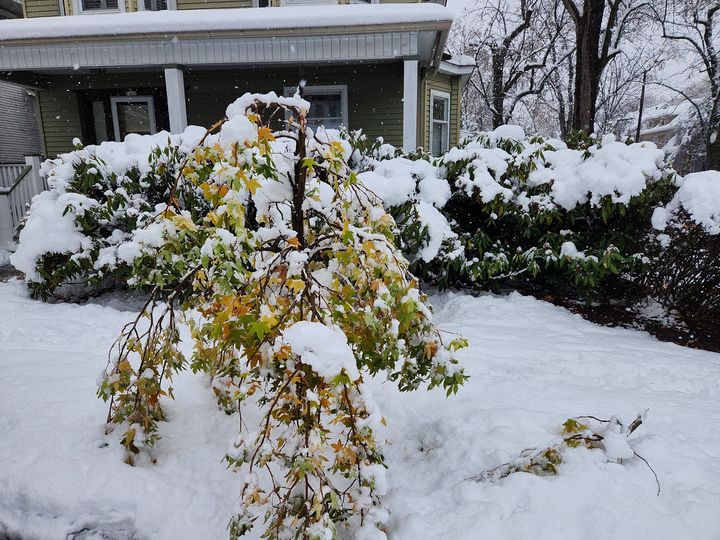From our upstairs bedroom window she looks seriously injured. One branch covered in wet thick snow lies frozen on the ground. Other branches droop from watery weight, hanging low as if bowed in mourning.
We call her our baby tree.
She’s a survivor who stands where her predecessors failed to grow. Over the years we’ve planted three trees near the corner where our 100-year-old house has stood through the ages. Each tree died. For a long time our baby tree looked like she wouldn’t survive, either, but she persevered.
We trimmed the top at the center branch about two years ago, giving her one last chance to succeed like a crew-cut Marine recruit giving a boot camp obstacle course everything she has. But even Tony the wise city tree expert pronounced our baby tree dead.
Stephanie said we should wait. Patience can invigorate baby trees as well as seasoned humans like us. So we waited. And one day the living tip of a tiny green bud appeared on our baby tree. More buds appeared in the following weeks. The smallest green leaves opened and turned wide as a child’s palm when she reaches to shake hands.
That first year made history. When Tony drove by and saw her dancing in the breeze he stopped to marvel. In his many years as an arborist planting, pruning, fertilizing and nurturing trees, he had never seen such a comeback.
“She’s a miracle tree,” he said.
“That’s our baby tree,” I said.
Sometimes I gently caressed her leaves and said, “You’re the most beautiful tree in Scranton.”
Sensing shyness and strength I spoke respectfully, not wanting to embarrass her or exert any more pressure than she already endured through tumultuous seasons and whatever evil lurked underground near the sewer grate that poisoned her forebears.
Our baby tree stood her ground.
The next year, and the year after that, she displayed powerful determination. Whatever power she carried in her genes convinced me she would thrive. Like people, she only lived so long. Like all life she, too, would one day succumb to nature and return to the universal mysteries that control life and death in all forms.
This fall our baby tree shined. Warm bright weather generated vivid fresh color dancing in golden sunlight among a beautiful buff coat of greenish-yellow leaves.
“She looks like a lemon lime popsicle,” I said one day not long ago as Stephanie and I walked down the hill on North Irving Avenue toward our sturdy old house. Our baby tree’s big sister stood beside her. Towering over her sibling in her own matching flourish of radiance, she stood swaying in a gentle breeze as testament to time and wonder.
Big sister came to us years earlier when a violent storm sent a massive tree crashing into the middle of East Gibson Street that could have destroyed our house had it fallen through the ancient wood. We have no control over which way the wind blows.
Or how hard the snow falls.
Later today I’ll lace up my trusty steel-toed boots, zip my worn black fatigue jacket to the neck and pull my watch cap over my head to go outside. I’ll use both hands and the broom to gently brush heavy snow from her limbs. I’ll talk quietly and tenderly, reminding her we’re here to do whatever we can to help.
Then we’ll hope for the best. Most people hope for the best at times like these. But we need to prepare for the worst. Nothing lives forever. Nothing is permanent. Still, we’re all connected — you, me, Stephanie and our baby tree.
Our roots will always run deep.



